
Powis Castle is a British medieval castle, fortress and grand country house near Welshpool, in Powys. The seat of the Herbert family, Earls of Powis, the castle is known for its formal gardens and for its interiors, the former having been described as "the most important", and the latter "the most magnificent", in Wales. The castle and garden are under the care of the National Trust. Powis Castle is a Grade I listed building, while its gardens have their own Grade I listing on the Cadw/ICOMOS Register of Parks and Gardens of Special Historic Interest in Wales.
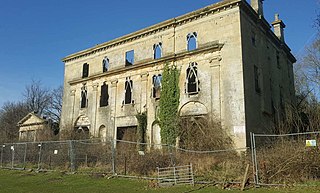
Piercefield House is a largely ruined neo-classical country house near St Arvans, Monmouthshire, Wales, about 1.5 miles (2.4 km) north of the centre of Chepstow. The central block of the house was designed in the very late 18th century, by, or to the designs of, Sir John Soane. It is flanked by two pavilions, of slightly later date, by Joseph Bonomi the Elder. The house sits within Piercefield Park, a Grade I listed historic landscape, that was created in the 18th century as a notable Picturesque estate.
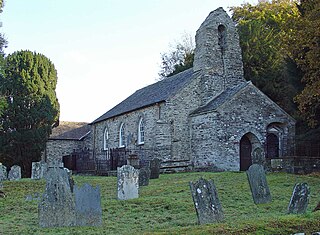
Manordeifi is a parish and community in the hundred of Cilgerran, in the northeast corner of Pembrokeshire, Wales. The population of the community in 2001 was 478. It has an elected community council and is part of the Cilgerran electoral ward for the purposes of elections to Pembrokeshire County Council.
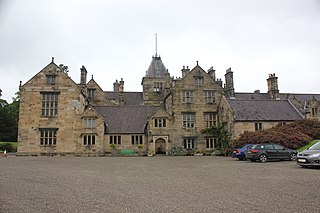
Mostyn Hall is a large house standing in 25 acres of garden near the village of Mostyn, Flintshire, Wales. It is designated by Cadw as a Grade I listed building.
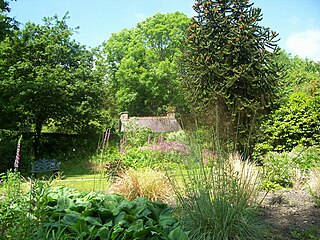
Colby Woodland Garden is a National Trust woodland garden in a secluded valley, approximately ¾ of a mile north of Amroth in Pembrokeshire, Wales. It is listed on the Cadw/ICOMOS Register of Parks and Gardens of Special Historic Interest in Wales.
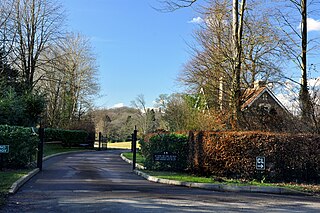
Coedarhydyglyn or Coedriglan, formerly Old Coedarhydyglyn, is a private Grade I listed neo-classical regency villa and estate on the western rim of Cardiff, less than half a mile from Culverhouse Cross, southeast Wales. It is accessed via the A48 road between Cardiff and St. Nicholas at the top of "The Tumble" hill leading up from Culverhouse Cross and Coedarhydyglyn Lane which leads to Drope to the north. The estate lies between the villages of St Georges-super-Ely and Downs just inside the boundary of the Vale of Glamorgan.

LlanvihangelCourt, Llanvihangel Crucorney, is a Tudor country house in Monmouthshire, Wales. The architectural historian John Newman, in his Gwent/Monmouthshire volume of The Buildings of Wales series described the court as "the most impressive and richly decorated house of around 1600 in Monmouthshire". The origins of the house are medieval, with a traditional date of construction of 1471. The building was given its present appearance by a substantial enlargement and re-casing of circa 1600 by Rhys Morgan, of the family of the original owners. In the very early 17th century it was owned briefly by Edward Somerset, 4th Earl of Worcester.

High Glanau is a country house and Grade II* listed building within the community of Cwmcarvan, Monmouthshire, Wales. It is located about 5 miles (8.0 km) south-west of Monmouth, and 1.5 miles (2.4 km) north of Trellech, adjoining the B4293 road and with views westwards over the Vale of Usk. Commissioned by Henry Avray Tipping and designed by Eric Francis, it is particularly noted for its gardens which are listed at Grade II* on the Cadw/ICOMOS Register of Parks and Gardens of Special Historic Interest in Wales.
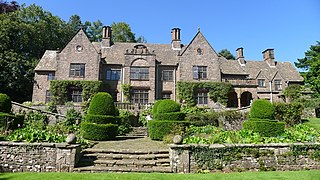
Wyndcliffe Court, 0.5 miles (0.80 km) north of the village of St. Arvans, Monmouthshire, Wales, is a Grade II* listed country house and gardens in the Arts and Crafts style, completed in 1922. The client was Charles Leigh Clay and the architect Eric Francis. The gardens were designed by Henry Avray Tipping and are included on the Cadw/ICOMOS Register of Parks and Gardens of Special Historic Interest in Wales.

There are around 1,000 listed buildings in Cardiff, the capital city of Wales. A listed building is one considered to be of special architectural, historical or cultural significance, which is protected from being demolished, extended or altered, unless special permission is granted by the relevant planning authorities. The Welsh Government makes decisions on individual cases, taking advice from the heritage agency Cadw, the Royal Commission on the Ancient and Historical Monuments of Wales and local councils.

In the United Kingdom, the term listed building refers to a building or other structure officially designated as being of special architectural, historical, or cultural significance; Grade I structures are those considered to be "buildings of exceptional interest". Listing was begun by a provision in the Town and Country Planning Act 1947. Once listed, strict limitations are imposed on the modifications allowed to a building's structure or fittings. In Wales, the authority for listing under the Planning Act 1990 rests with Cadw.

In the United Kingdom, the term listed building refers to a building or other structure officially designated as being of special architectural, historical, or cultural significance; Grade II* structures are those considered to be "particularly important buildings of more than special interest". Listing was begun by a provision in the Town and Country Planning Act 1947. Once listed, strict limitations are imposed on the modifications allowed to a building's structure or fittings. In Wales, the authority for listing under the Planning Act 1990 rests with Cadw.

Monmouthshire is a county and principal area of Wales. It borders Torfaen and Newport to the west; Herefordshire and Gloucestershire to the east; and Powys to the north. The largest town is Abergavenny, with the other major towns being Chepstow, Monmouth, and Usk. The county is 850 km2 in extent, with a population of 95,200 as of 2020. The present county was formed under the Local Government (Wales) Act 1994, and comprises some sixty percent of the historic county. Between 1974 and 1996, the county was known by the ancient title of Gwent, recalling the medieval Welsh kingdom. In his essay on local government in the fifth and final volume of the Gwent County History, Robert McCloy suggests that the governance of "no county in the United Kingdom in the twentieth century was so transformed as that of Monmouthshire".

This is a list of Grade II*-listed buildings in the county of Pembrokeshire, Wales.

In the United Kingdom, the term listed building refers to a building or other structure officially designated as being of special architectural, historical, or cultural significance; Grade II* structures are those considered to be "particularly important buildings of more than special interest". Listing was begun by a provision in the Town and Country Planning Act 1947. Once listed, strict limitations are imposed on the modifications allowed to a building's structure or fittings. In Wales, the authority for listing under the Planning Act 1990 rests with Cadw.

Rhiwlas is an estate about 1 km (0.62 mi) to the north of the town of Bala, Wales. It has been in the possession of the Price family for over four centuries. Rhiwlas Hall, a Regency extravaganza, was demolished in the 1950s and replaced by a smaller house designed by Clough Williams-Ellis. Many of the estate buildings remain and are listed structures and the hall's gardens and landscaped park, landscaped by William Emes, are listed at Grade II on the Cadw/ICOMOS Register of Parks and Gardens of Special Historic Interest in Wales.

Llanerch Hall, Trefnant, Clwyd, Wales, is a country house with medieval origins. It was rebuilt twice at the beginning and at the end of the 17th century, was again rebuilt in the 19th century, and further modified in the 20th. The hall is now divided into flats, each with its own Grade II* listing. The parkland, now a golf course, conceals traces of a late 17th century Italianate terraced garden that rivalled those at Powis Castle. The gardens were entirely destroyed in the 19th century rebuilding. The house remains privately owned.

Tal-y-coed Court,, Llanvihangel-Ystern-Llewern, Monmouthshire, Wales, is a Victorian country house. Constructed in 1881–1883, it was built for the Monmouthshire antiquarian Joseph Bradney, author of A History of Monmouthshire from the Coming of the Normans into Wales down to the Present Time. A Grade II* listed building, the house is a "fine historicist essay in the Queen Anne Style, one of the earliest examples in Wales." Its gardens and park are designated Grade II on the Cadw/ICOMOS Register of Parks and Gardens of Special Historic Interest in Wales.

Trewyn House, Llanvihangel Crucorney, Monmouthshire, Wales, is a country house dating from 1692. Its origins are older but the present building was constructed by the Delahayes at the very end of the 17th century when the house sat in Herefordshire. It has since been extended and reconstructed giving an "obscure and complicated" building history. The house is Grade II* listed. The parkland has traces of 17th-century terracing and a rare Grade II* listed dovecote. It is listed Grade II on the Cadw/ICOMOS Register of Parks and Gardens of Special Historic Interest in Wales.

Craig-y-parc House is a country house in Pentyrch, Cardiff, Wales. Dating from 1914 to 1918, it was built for Thomas Evans, a colliery owner, by Charles Edward Mallows. The house reputedly cost £100,000. Craig-y-parc is a Grade II* listed building. The garden and park surrounding the house has its own Grade II* listing on the Cadw/ICOMOS Register of Parks and Gardens of Special Historic Interest in Wales, is a designated conservation area and contains a number of listed structures. The house now operates as a residential school for children and young adults with disabilities.






















